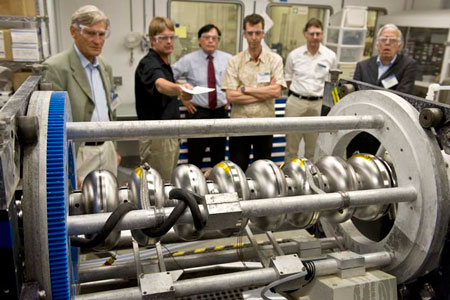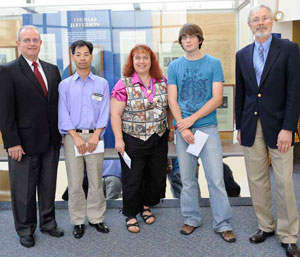
|
July 2008
|
|
|
The U.S. Department of Energy's Thomas Jefferson National Accelerator Facility
|
|
JLab's 12 GeV Upgrade Project Clears Critical Hurdle |
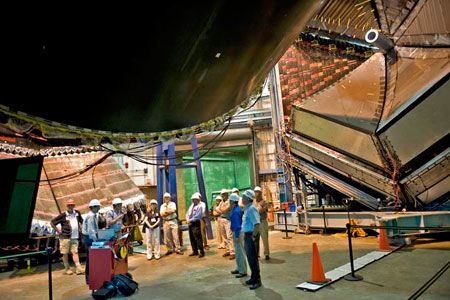 Independent Project Review committee members, visiting JLab to evaluate the readiness of the 12 GeV Upgrade project, tour Hall B during their site visit. Here they view the CEBAF Large Acceptance Spectrometer as Hall B Leader Volker Burkert and Lead Engineer Dave Kashy explain the system.
The U.S. Department of Energy's Thomas Jefferson National Accelerator Facility successfully completed on a major review on July 24 as it seeks approval to start construction on a planned $310 million project that will double the energy of the electron beam used in nuclear physics experiments. An Independent Project Review panel from the DOE Office of Science's Office of Project Assessment concluded that designs for the so-called 12 GeV Upgrade are impressive and the project is ready for the start of construction. The 25-member team headed by Daniel R. Lehman, director of the Office of Project Assessment, examined all aspects of the project, including technical, cost, schedule, management, and safety during a three-day session held at Jefferson Lab. The review was required before the lab can request DOE approval to start construction, or what is known as Critical Decision-3 or CD-3. Construction is expected to begin in the 2009 Fiscal Year. JLab Director Christoph Leemann thanked the review team, the DOE, the scientific user community; the laboratory and "above all, members of the project team, all of whom contributed to the success of the review and the success of the project."... more |
|
|
Safety Comes First
|
S&T Review Ends on High Note
|
Sen. Warner Named 'Friend of Science'
|
||
|
|
||||
Below the Fold: |
||||
JLab's 12 GeV Upgrade Project Clears Critical Hurdle |
 Independent Project Review committee members, visiting JLab to evaluate the readiness of the 12 GeV Upgrade project, tour Hall B during their site visit. Here they view the CEBAF Large Acceptance Spectrometer as Hall B Leader Volker Burkert and Lead Engineer Dave Kashy explain the system.
The U.S. Department of Energy's Thomas Jefferson National Accelerator Facility successfully completed on a major review on July 24 as it seeks approval to start construction on a planned $310 million project that will double the energy of the electron beam used in nuclear physics experiments. An Independent Project Review panel from the DOE Office of Science's Office of Project Assessment concluded that designs for the so-called 12 GeV Upgrade are impressive and the project is ready for the start of construction. The 25-member team headed by Daniel R. Lehman, director of the Office of Project Assessment, examined all aspects of the project, including technical, cost, schedule, management, and safety during a three-day session held at Jefferson Lab. The review was required before the lab can request DOE approval to start construction, or what is known as Critical Decision-3 or CD-3. Construction is expected to begin in the 2009 Fiscal Year. JLab Director Christoph Leemann thanked the review team, the DOE, the scientific user community; the laboratory and "above all, members of the project team, all of whom contributed to the success of the review and the success of the project." "It is gratifying and rewarding," Leemann said, "to see years of tenacity and perseverance come to fruition, to have established a solid place in the scientific landscape, to have an outstanding team and excellent systems in place and integrated into the laboratory, and to look forward to start the great enterprise of actually building the upgrade. I remain convinced that advancing this project with all the vigor we are capable of is the best we can do for the future of the laboratory." Jehanne Simon-Gillo, acting associate director of the Office of Science for Nuclear Physics, praised the work done by the review committee and thanked its members for a well-managed and outstanding job. She also had complimentary words for the 12 GeV Project team and Leemann, who will retire at the end of August, for bringing the project to an important milestone. "The laboratory and 12 GeV Project team, under Christoph Leemann's leadership, have done an excellent job in keeping this project on track, and the outcome of the review clearly shows that they are ready for the initiation of construction," says Simon-Gillo. "The laboratory has made the 12 GeV Project its highest priority during times of constrained budgets, and this has not been without consequence to its current program. The efforts and sacrifices on behalf of the laboratory, as a whole, in bringing the 12 GeV project to this stage are recognized and appreciated." To explore protons and neutrons, Jefferson Lab's accelerator propels a beam of electrons at nearly the speed of light around a massive underground "racetrack" that is 7/8 mile around. The speeding electrons strike the protons and neutrons within the atom's nucleus. Huge detectors then measure the speed, direction, and energy of the scattered particles, so scientists can study the most fundamental constituents of matter. The facility, which operates on a 206-acre campus, employs more than 650 people and is a center for nuclear physics research and education. It is one of 17 national laboratories and facilities overseen by DOE and is managed and operated by Jefferson Science Associates, LLC, a company formed by the Southeastern Universities Research Association and Computer Sciences Corp. |
Safety Comes First |
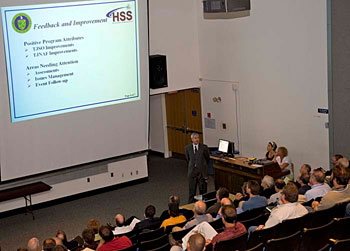 Thomas Staker, director of the Department of Energy's Office of Environment, Safety and Health Evaluations and leader of the Health, Safety and Security team that evaluated JLab, presents the team's results at JLab on July 10. The team provided an extensive inspection of environment, safety and health programs at Jefferson Lab in May and June. When it comes to providing for the safety of employees and visiting researchers and protecting the environment, Jefferson Lab is among the best. "I don't compare the labs, but the results here are very good," said Thomas Staker, who led a team of inspectors that conducted an extensive inspection of environment, safety and health programs at Jefferson Lab in May and June. Staker is director of the U.S. Department of Energy's Office of Environment, Safety and Health Evaluations. During a presentation of the team's findings and draft results report on July 10, Staker noted that JLab received high marks (effective performance ratings) in 11 of 13 categories. "That's a pretty good report card," he added. "It's a very rewarding outcome," said Lab Director Christoph Leemann. "Something became very clear in this effort and that is that the commitment to safety and the systems are in place on the work floor and have been embraced by the workers. Safety at JLab is really carried by the workers." The seven-member inspection team reviewed four areas of the lab's operations: feedback and improvement processes, the Free-Electron Laser, the Test Lab, and facilities management and logistics. As Staker explained, the team took a "performance-based look" at these areas with an eye toward helping the lab improve its operations. What the team found were outstanding "core function" practices at the Test Lab, the Free-Electron Laser and within the Facilities Management and Logistics group. The inspection identified four findings the lab needs to address and one for the DOE Thomas Jefferson Site Office. The "positive attributes" cited by the inspection team include:
 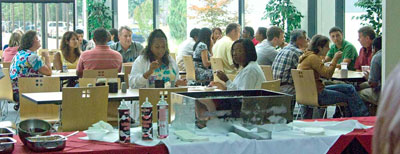 JLab celebrated the successful completion of the Health, Safety and Security inspection with ice cream sundaes on July 7.
Staker noted that his office has inspected eight nanotechnology facilities at other national labs and that Jefferson Lab's was "among the best." He added that the lab's Subcontracting Officer's Technical Representatives, who are part of the facilities management group, also are "among the best we've seen in the DOE complex." "Site Office, lab management and worker attention to safety is evident in the observed, effective establishment of controls for activity level work and improvements in feedback and important processes," the inspection team draft report said. While the draft report was overwhelmingly positive, Staker noted that "there are areas needing attention," adding that "further work needs to be done." The areas of "particular priority and emphasis" listed by the inspection team in its draft report are: evaluating and enhancing forklift safety programs; continuing enhancement of the work control process; enhancing the Contractor Assurance System; and establishing and implementing a well-defined infrastructure for document control and effective management and communication requirements. DOE TJ Site Office Manager, James Turi, thanked the inspection team for "conducting a review that was thorough and comprehensive, and provided a good snapshot of the lab and the site office." The inspection team plans to issue a final report on its inspection by mid-August. After the report is completed, the lab and site office will have 60 days to submit a corrective action plan that addresses the findings. |
Sen. Warner Named 'Friend of Science' |
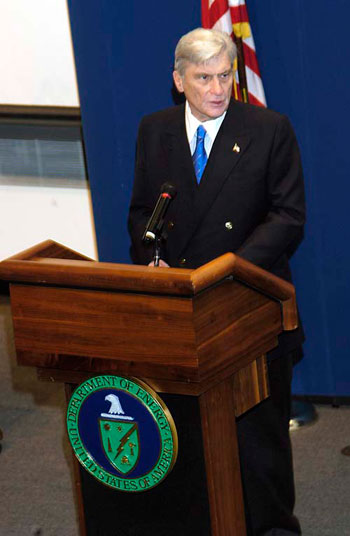 Senator John Warner, who was key in bringing Jefferson Lab to Virginia, addressed the lab community April 19, 2004, when the DOE announced Critical Decision Zero (CD-0) for the lab's 12 GeV Upgrade project. When the federal government launched a competition in 1982 to build an electron accelerator, Sen. John Warner was among the first to back a proposal by the Southeastern Universities Research Association to locate the facility in Newport News. His support marked the beginning of a long relationship that has greatly benefited SURA and the Thomas Jefferson National Accelerator Facility. On June 17, SURA recognized Warner's strong support for SURA and JLab by presenting him with its Distinguished Friend of Science Award. The award recognizes those "whose extraordinary efforts within the SURA region fulfill the SURA mission of strengthening the scientific and technical capabilities of the Southeast and nation." "Senator Warner has been a great friend to the science and technology community and the role of higher education to advance research and economic competitiveness. He's been a strong advocate for our nation's education and science agenda," said William R. Harvey, President of Hampton University and past chair of the SURA Council of Presidents and Executive Committee. Warner's support of Jefferson Lab has been critical to its success, noted Jefferson Lab Director Christoph Leemann. "He understands the importance of the lab's research, and he has always done all that he can to help us fulfill our mission," Leemann added. "His leadership, vision and impact on the lab cannot be underestimated." After pushing for Jefferson Lab to be built in Newport News, Warner used his clout in the senate to steer millions of dollars to fund the lab's construction and its science programs. He also helped secure the first funding for the free-electron laser program and worked to provide it millions of federal dollars over the years. Recently, he's been a vocal and strong backer of the 12 GeV Upgrade project. In addition to backing the lab in Washington, Warner also has been a frequent visitor to the lab, touring its facilities and participating in events such as the dedication of CEBAF in 1996. "Senator Warner has been a great friend to SURA, the Jefferson Lab and our nation's scientific and research interests, and therefore is deserving of this important recognition," University of Virginia President John Casteen wrote in his letter nominating the senator. He added, "Senator Warner has worked in the Senate to provide incentives for America's college and university students to enter the very critical fields of math, science and engineering." SURA is a consortium of 63 leading research institutions in the southern United States and the District of Columbia, and was the founding operator of Jefferson Lab. The organization established the Distinguished Friend of Science Award in 2006 to commemorate its 25th anniversary. Each SURA member institution is eligible to make one nomination for the award. Warner began his public service in 1945 when he joined the Navy at age 17. He later attended Washington & Lee University on the GI Bill, and then entered the University of Virginia Law School. At the outbreak of the Korean War, Warner interrupted his law studies and commenced a second tour of active military duty. Upon his return from Korea, Warner finished his law degree and in 1956, was appointed an Assistant U.S. Attorney. He entered private law practice in 1960. Warner resumed his public service with his Presidential appointment to be Under Secretary of the Navy in 1969. For over five years during the war in Vietnam, he served in the Department of the Navy, and led the Department as Secretary from 1972-1974. Warner won five consecutive elections to the U.S. Senate, beginning in 1978. Now the second-longest serving U.S. senator from Virginia in the 219-year history of the Senate, he will not seek reelection when his term expires in 2009. |
Below the Fold |
Strong Start for Young Researchers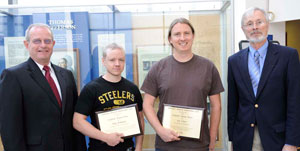 Two young investigators claimed the 2007 Jefferson Science Associates Thesis Prize. Michael Williams (center, left), Carnegie Mellon University and Ian Cloet, University of Adelaide, presented their respective works at the Users Group Workshop and Annual Meeting at Jefferson Lab on June 18. They received their $2,000 awards from Jerry Draayer (far left), president and CEO of the Southeastern Universities Research Association, and JLab Director Christoph Leemann.
Jerry Draayer (far left), president and CEO of the Southeastern Universities Research Association, and JLab Director Christoph Leemann presented cash awards to the winners of the Jefferson Science Associates Poster Contest held during the JLab Users Group Workshop and Annual Meeting. The poster session was held June 16. Placing first and earning $1,000 was the poster by Jixie Zhang (left), Old Dominion University: Exclusive Electro-production of Negative Pions from the Neutron in the Resonance Region. Second place and $500 went to Sharon Careccia, Old Dominion University, with her poster: Double Spin Asymmetry for Exclusive Negative Pion Production from Deuterium. Third place and a $250 prize went to Pieter Vancraeyveld, Ghent University, Belgium: Electromagnetic Production of Kaons from the Proton in the Regge-plus-resonance Model.
The theory of the strong force lies at the heart of research carried out by two young investigators that together claimed the 2007 Jefferson Science Associates Thesis Prize. Prize winners Michael Williams of Carnegie Mellon University and Ian Cloet of the University of Adelaide presented their work at the Users Group Workshop and Annual Meeting at Jefferson Lab on June 18. Michael Williams Williams earned his Ph.D. from Carnegie Mellon University with a partial wave analysis of experimental data he and his colleagues collected in the g11a run period in Hall B. His research was aimed at revealing signatures of never-before-seen excited states of protons and neutrons, or nucleons. An excited state is one in which ordinary nucleons vibrate with extra energy, essentially becoming a new particle. Williams' analysis of the g11a data revealed several signatures and possible signatures of these excited states, called nucleon resonances. "I did a partial wave analysis, where you try to decompose what you measure and figure out what was actually happening – what the physics was that produced what you see," Williams said. "We found evidence for nucleon resonance contributions." He says these resonances can provide insight into the strong force that binds quarks and gluons into protons and neutrons, and eventually, nuclei. The strong force is described by the theory of Quantum Chromodynamics, or QCD. "QCD predicts the resonance spectrum, and by measuring it, you can provide a test for that theory," he noted. Following his Ph.D., Williams accepted a postdoctoral position at Carnegie Mellon, where he is continuing work begun with his thesis and is also contributing to Jefferson Lab's 12 GeV Upgrade GlueX work.  Ian Cloet "We calculated the polarized EMC effect and found it to be twice as large as the unpolarized EMC effect. And this polarized EMC effect is telling us about how the spin of the nucleon changes when it's in the nucleus," he said. The EMC effect – named for the European Muon Collaboration – was first reported in 1983. Cloet said his work also addresses QCD by revealing a new detail of the theory of how the strong force builds the heart of most visible matter in the universe. "In a lot of ways, the ultimate goal of quantum chromodynamics is to start with the quarks and the gluons and to use those to eventually be able to calculate the properties of nuclei," he said. More on Cloet's work can be found in an article posted after the publication of the Physical Review Letters paper on this result. Following his Ph.D., Cloet took a postdoctoral position at Argonne National Lab and will soon continue his work with a second postdoc at the University of Washington. Established in 1999, the Thesis Prize is awarded to a graduate student who has carried out research related to Jefferson Lab science. It is awarded to the graduate student with the best thesis and includes a stipend of $2,000 and a commemorative plaque. Four areas are considered in rating the submitted theses: the quality of the written dissertation, the student's contribution to the research, the work's impact on the field of physics and service (how the work benefits Jefferson Lab or other experiments). By Kandice Carter Dick Owen Joins Industrial Hygiene and Safety Team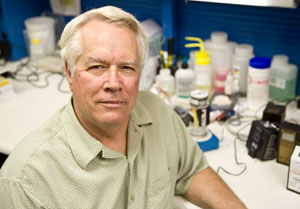 Richard Owen is the newest member of JLab's Industrial Hygiene and Safety team.
You might say that Dick Owen is a man who almost never was. His dad was aboard the USS West Virginia at Pearl Harbor on Dec. 7, 1941, which was immediately astern of the USS Arizona and took a barrage of torpedoes during the surprise attack. "This isn't good," his dad thought as the Arizona exploded and he jumped over the side of the West Virginia as it sank to the bottom of the harbor. In the ensuing chaos, Dick's grandparents were told that their son had been killed. When his father turned up safe and very much alive, the Navy sent him home for a few weeks of rest and recuperation. He subsequently met and married Dick's mother and they had four children. Dick, their second child, is Jefferson Lab's newest addition to the industrial hygiene and safety team, joining Jennifer Williams, Brett Lewis and Mary Boggs. Raised in southwestern Ohio, Dick Owen describes himself as a student who was always drawn to science. He graduated from Texas A&M University in 1972 and then landed a job as a safety engineer with Aetna Life & Casualty in Shreveport, La. While there, he met his wife, Joan, who also worked for the company. Not long after their marriage, a former professor who remembered Owen as an excellent student offered him a National Institute for Occupational Safety and Health grant to complete a master's degree at Texas A&M. He completed all the course work and his thesis, which usually takes two years, in just 11 months. "I didn't understand that I could renew my grant for another year," he recalled with a laugh. "I thought I had one year and that was all I had." After completing his master's in Industrial Hygiene, he took a position with Pratt & Whitney Aircraft in East Hartford, Conn., where he served for 14 years as a resident expert in identifying, evaluating and recommending controls of occupational health and safety situations for the company’s 40,000 employees. During this period, he traveled extensively, including stops in Italy, Singapore, England and Canada. He followed that with 16 years at Solutia, Inc., in Springfield, Mass., a specialty chemical manufacturer for whom he was the lead industrial hygienist. Solutia facilities worldwide sought out Owen for advice on improving their respective work environments. Since Pratt & Whitney and Solutia were equi-distant from his Connecticut home, albeit in opposite directions, his family, which by then included three sons, didn’t move. During those years in Connecticut, while working full time and raising a family, Owen also taught industrial hygiene courses in the Industrial Technology Department at Central Connecticut State University in New Britain, Conn. In addition, he served as a Boy Scout leader for more than 16 years. He received numerous scouting awards such as the Silver Beaver and was voted into the prestigious Order of the Arrow and ultimately received the group's Vigil Honor. Owen arrived at Jefferson Lab in early May and says he has been working hard to acclimate himself to this new environment. "It's been hectic," he said. "There are procedures specific to the lab to learn, all the different divisions and how things are done here, not to mention Department of Energy and site protocols." Many people, he said, don’t understand the difference between safety issues, which have to do with events at a specific time and place, and industrial hygiene, which often takes a longer view and is concerned with health effects that develop over many years or even decades and tries to predict what current exposures could become health issues in the years to come. The formal definition of industrial hygiene states that it's the art and science of recognizing, evaluating and controlling occupational health hazards from biological, chemical, physical and ergonomic sources. Owen explained, "This field requires a working knowledge of chemistry, physics, engineering, physiology, biology, kinesiology/ergonomics, medicine, pharmacology, toxicology and legal issues." He's excited about the opportunity to bring his expertise in industrial hygiene safety to the lab's staff and users. "It's not in everyone's fields to recognize subtle hazards and safety issues," he said. "That's why we're here. The Jefferson Lab community can rely on the industrial hygienists' expertise." By Judi Tull JLab Group Goes to the Dogs – Therapy Dogs – That Is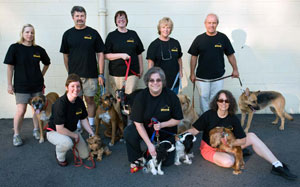 The JLab Activities Group dog training club is open to all employees, users, family members and their dogs. Members and their dogs recently posed for a group photo after they were evaluated for the Canine Good Citizen and Therapy Dog International certification. For the last several weeks, the dogs and owners followed a training program that permits them to take the first step in becoming therapy dog/handler certified.
The Jefferson Lab Activities Group Dog Training Club passed its first milestone July 16. The dogs and their owners were evaluated for the Canine Good Citizen and Therapy Dog International certification. "And passed!" according to Joyce Miller, dog training club captain and Physics Division staff member. The Canine Good Citizen, CGC, is a certification program of the American Kennel Club that is designed to reward dogs who have good manners at home and in the community. The dogs and handlers must complete a 10-step test that includes sit and down on command; staying in place and coming when called. The primary objective of the Therapy Dog International, TDI, dog and handler is to provide comfort and companionship by sharing the dog with patients in hospitals, nursing homes and other institutions. This is done in a way that increases emotional well being, promotes healing, and improves the quality of life for the people being visited and the staff that cares for these people. One of the TDI evaluators, Helen Noles, said this about the JAG Dog Training Club group: "The dogs were well prepared and a very nice group of handlers and dogs. It is such a pleasure to test dogs and handlers who are prepared!" The JAG Dog Training Club is open to all employees, users, family members and their dogs. The club meets on Wednesday evenings at 7 p.m. at Dixie RV Rentals, across the street from the lab. Current members of the club are: Joyce Miller, captain; Brian Kross, co-captain; Cindy Saban, Jen Monaghan, Bert Manzlak, Ingrid Kross, Nancy Kinzinger, Marge Parker, Sasha Stolin, Jan Tyler, Tom Grummell and Drew Weisenberger. The club sends out a big "thank you" to Crosby Forrest and Lynn Dalheimer of Dixie RV Sales for permitting use their facility. Members of the JLab community interested in becoming a member of the dog club may contact Miller (ext. 7163 or miller@jlab.org) or Brian Kross (ext. 7022 or kross@jlab.org). U.S. Completes Contribution to Large Hadron ColliderWASHINGTON, DC - The U.S. contribution to the Large Hadron Collider has been completed on budget and ahead of schedule, the U.S. Department of Energy and the National Science Foundation reported June 30. The LHC, located near Geneva, Switzerland at the CERN laboratory, is the largest international scientific facility ever built. The U.S. contribution, a $531 million investment, consists of several key components of the particle accelerator and the ATLAS and CMS particle detectors. "The success of the U.S. LHC project is based on the quality of the U.S. teams, and national and international collaboration," DOE Under Secretary for Science, Dr. Raymond L. Orbach said. "The U.S. groups, from universities and national laboratories, worked extraordinarily well together. We celebrate their accomplishments and, together with them, look forward to extremely exciting science coming from the LHC." Scientists predict that the LHC's very-high-energy proton collisions will yield extraordinary discoveries about the nature of the physical universe. The LHC is currently undergoing final assembly and first particle collisions are expected later this year. When the LHC experiments begin scientific operations, U.S. physicists will make up the largest group of scientists from any single nation. CMS (the Compact Muon Solenoid) and ATLAS are two LHC experiments designed to explore the physics of the Terascale, the energy region where physicists believe they will find answers to some of the central questions at the heart of 21st-century particle physics: Are there undiscovered principles of nature? How can we solve the mystery of dark energy? Are there extra dimensions of space? What is dark matter? How did the universe come to be? Many universities and laboratories contributed to the decade-long project – which was completed ahead of the planned Sept. 30, 2008 milestone – to design, fabricate, install, integrate and commission the U.S. components. The U.S. LHC project efforts were overseen by DOE's Office of High Energy Physics and the NSF Elementary Particle Physics program, with significant assistance from DOE's Office of Project Assessment. For more information on the project, visit http://www.uslhc.us/ . (DOE news release) Milestones for mid-June through mid-July 2008Hello Move Goodbye Chen Yan, Staff Scientist, Experimental Nuclear Physics DivisionThese Milestone entries, listed alphabetically, are actions posted by Human Resources from mid-May to mid-June 2008. Current JLab career opportunities are posted at: https://careers.peopleclick.com/careerscp/client_jeffersonlab/external/search.do |
|
The On Target newsletter is published monthly by the Thomas Jefferson National Accelerator Facility (Jefferson Lab), a nuclear physics research laboratory in Newport News, Virginia, operated by Jefferson Science Associates, LLC, for the U.S. Department of Energy's Office of Science. Possible news items and ideas for future stories may be emailed to jlabinfo@jlab.org, or sent to the Jefferson Lab Public Affairs Office, Suite 15, 12000 Jefferson Avenue, Newport News, VA 23606
|


 When it comes to providing for the safety of employees and visiting researchers and protecting the environment, Jefferson Lab is among the best.......
When it comes to providing for the safety of employees and visiting researchers and protecting the environment, Jefferson Lab is among the best....... The Department of Energy's annual Science and Technology Review of Jefferson Lab ended July 2 on a high note, with a nod to the past and the future, and a farewell salute from Lab Director Christoph Leemann........
The Department of Energy's annual Science and Technology Review of Jefferson Lab ended July 2 on a high note, with a nod to the past and the future, and a farewell salute from Lab Director Christoph Leemann........ When the federal government launched a competition in 1982 to build an electron accelerator, Sen. John Warner was among the first to back a proposal by the Southeastern Universities Research Association to locate the facility in Newport News .....
When the federal government launched a competition in 1982 to build an electron accelerator, Sen. John Warner was among the first to back a proposal by the Southeastern Universities Research Association to locate the facility in Newport News .....